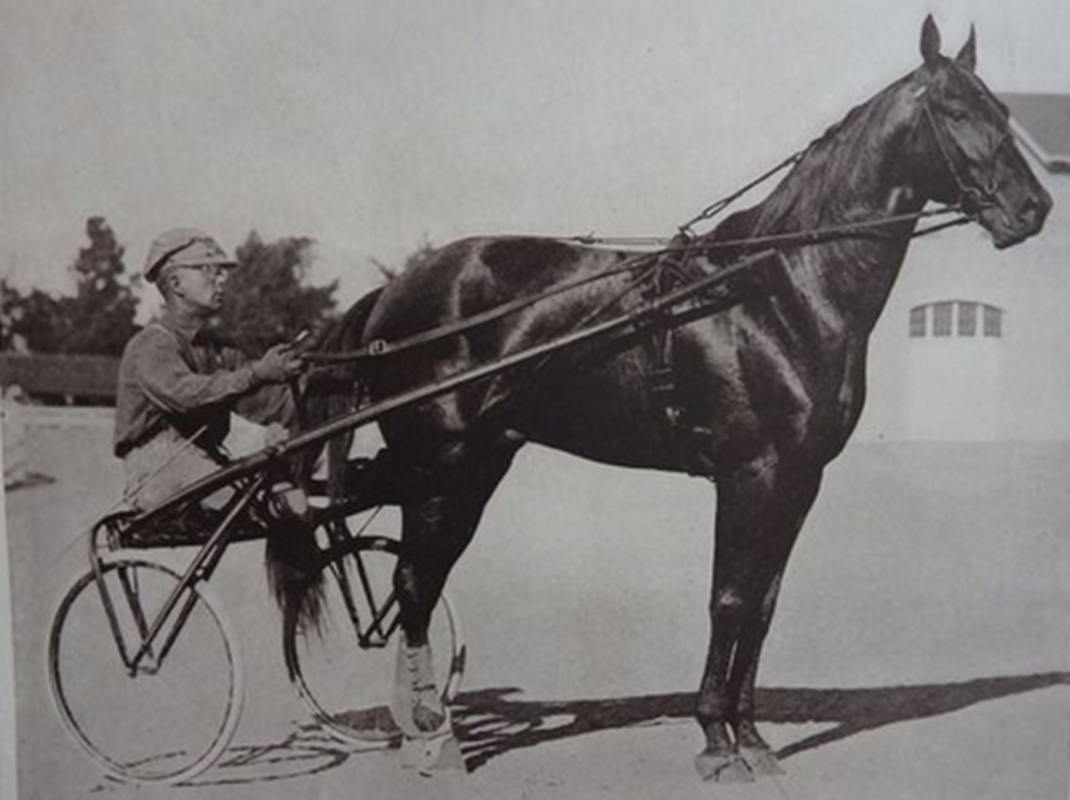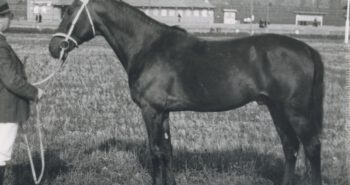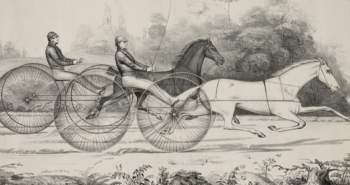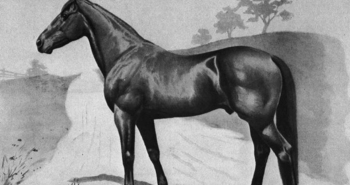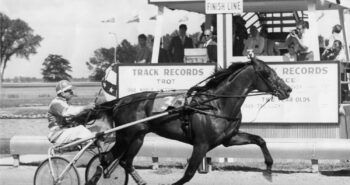He was a slight two-year-old who was sold off in the belief that he had no future. However, the 15 hands/152 cm trotter grew to be a spectacular animal with exceptional speed and strength and, most of all, extreme courage and gameness. “Little Lee” would indeed be the biggest, before he tragically died way too soon.
Foaled at the legendary nursery Walnut Hall, Lee Axworthy was one of 45 yearlings sent to the Old Glory sale at Madison Square Garden in November 1912 as part of their consignment, though the colt was actually bred by William Bradley, proprietor of Ardmaer Farms of Raritan, NJ. He was bought by Walter Cox for $510, more than double the auction’s yearling average of $236.
He didn’t own the horse for too long, though. According to well-known journalist Will Gahagan, “Cox gave Lee a record of 2:28 1/4 (1.32,1) the following year, but decided that the son of Guy Axworthy and Gaiety Lee was a ‘lemon’. Before the season was over Cox dealt him to the Pastime Stable and threw in Prince Loree and some cash for a trotted called Sir Thomas Lipton. Walter is regarded as a pretty shrewd horseman, but in this particular case the slim Yankee pulled a real ‘boner’, for Lee Axworthy proved to be the greatest trotting stallion of all time, while Prince Loree, after being matineed a year or so and traded a time or two, turned out to be the leading money-winning aged trotter of the 1918 season which just came to a close, having something like $13,500 to his credit, also a mark of 2:05 1/4 (1.17,8).”
From a lemon to a star
Turned over to trainer William Andrews, Lee Axworthy was taken to Thomasville, GA with the rest of the Pastime stable that winter. Andrews just kept working the colt, who after a slow start gradually got better and better. According to one report in Cleveland newspaper The Plain Dealer on Jun 12, 1914, “Billy Andrews has stepped Lee Axworthy a mile in 2:13 1/2 (1.23,0), last half in 1:03, the third quarter being in 30 1/2. The colt finished strong and within himself”. According to Gahagan, “Although he acted like a counterfeit in the work early in the spring, Andrews stated that he was a great trotter and just kept hammering at him. No brush system was used on the youngster but he was given plenty of miles and eventually he began to show real class. After he got squared away, Lee Axworthy came fast in his work and before racing time came along, Andrews had molded him into a star 3-year-old.”
It wasn’t easy being a three-year-old trotter in 1914, though, as the crop contained the almost invincible Peter Volo. With the latter absent, Lee Axworthy got off to a perfect start in the Fasig Stake at North Randall when he won his season debut in July. He did so in two straight heats in 2:08 3/4 and 2:08 (1.20,0 and 1.19,6), the latter a new track record at the Cleveland oval. The following month he went head to head with Peter Volo in the Horseman Futurity at Kalamazoo. In the first heat, Peter Volo immediately went to the front, but Andrews showed absolutely no respect for the multiple world champion. He steered forward and applied pressure on Peter Volo with Lee Axworthy, while the four other starters were never in the race. The pace was very high as the two enemies came to the half in 30 1/2 and half in 1:01. He kept right at Peter Volo until down the final stretch where he faded a bit. Still, he forced Peter Volo to a 2:04 3/4 (1.17,5) time, equaling Colorado E’s world record for three-year-olds, himself timed in 2:05 1/2 (1.18,0). The second heat was more of the same as Peter Volo won in 2:05 3/4 (1.18,2), and in the third Lee Axworthy made a break at the five-eighths, allowing Peter Volo to win comfortably in 2:06 3/4 (1.18,8). Even though Lee Axworthy finished second, he had still forced Peter Volo to a three-heat world record for three-year-olds.
The massive effort apparently didn’t take anything out of Lee Axworthy. With Peter Volo sitting out the Grand Circuit meeting at Syracuse on Sep 1, the Guy Axworthy son breezed home The Ka-Noo-No for three-year-olds in three straight heats without any problems. A rematch with Peter Volo in the Matron at Hartford ten days later proved a disappointment as the horse was lame. Lee Axworthy finished second, but this time Peter Volo had it easy and won both heats without having to work much for it. Still suffering from small problems, the same thing repeated itself in the Horse Review Futurity at Colombus two weeks later, Lee Axworthy actually splitting second money with Lady Wanetka.
Andrews had ten days from the Horse Review to Kentucky Futurity and spent that time well. Says Gahagan, “it was in the Kentucky Futurity that he really showed his best form of the season. Again stacked against Peter Volo, he finished two-two-three in 2:07 1/4, 2:05 and 2:03 1/2 (1.19,1 and 1.16,8). He forced Peter Volo to trot the last half of the first heat in 1:01 1/4 and the quarter in 29 3/4, and was at the winner’s necktie when they came to the wire. In the second heat he again tried out the Murphy entry, and this time he forced Peter to trot the last half in 1:00 1/4, and finished with his nose at the leader’s flank. Had Peter Volo been out of the way that year Lee Axworthy would have been the sensation of the season.”
The challenge
Ahead of the colt’s four-year-old season, Andrews was extremely positive. “I have no pacers of Championship ability, but judging from the way Lee Axworthy wintered I believe that I have a champion trotter. I believe that Lee will be perfectly able to give Peter Volo and Etawah all the argument they desire this summer, and will not be surprised if the Pastime colt gives the four-year-old mark of 2:03 1/4 (1.16,6), by Etawah, a jolt. We may decide to let him have a try at the world’s stallion mark of 2:01 (1.15,2), held by The Harvester.” The members of the Pastime stable, Harry K Devereux, Coburn Haskell and PW Harvey of Cleveland, as well as Frank Ellis of Philadelphia, thought just as highly of their spectacular trotter. In late March they issued a direct challenge to WED Stokes and Frank G Jones, owners of Peter Volo and Etawah, respectively, for a match race with Lee Axworthy to be contested at North Randall during the Grand Circuit meeting there in July. On behalf of Pastime Stable, Harvey posted $5,000 with the magazine The Trotter and Pacer as collateral and issued the challenge with the terms, play or pay, winner take all. It showed supreme confidence, but wasn’t taken seriously by all trotting followers since the others have records five seconds faster than the Guy Axworthy son who had always played second fiddle to Peter Volo in 1914. The proposed match raced would not happen in July, though: Jones and Pop Geers, Etawah’s trainer, wrote Devereux to let him know that Etawah was unable because of stud duty, while Peter Volo’s trainer Tommy Murphy stated it was too early for his colt – adding that they’ll tackle Lee Axworthy later in the season “for any amount.”
Instead Lee made his 1915 seasonal debut in the 2:08 trot at North Randall, despite Andrews thought the horse unfit to start. However, Devereux and Haskell “said they favored starting Lee even if he did not race again this season. They realized the home folks wanted to see the horse trot and they wanted to satisfy that interest in the star four year old.” Injured or not, the outcome didn’t change. “Lee Axworthy proved more than a little lame when the horses were called for the 2:08 trot, but his owners decided to start him, and he rewarded them by trotting a beautiful race, outclassing a field and trotting the fastest opening heat in the history of the circuit when he negotiated the big ring in 2:05 1/4 (1.17,8).” The second heat was also an easy win, now in 2:06 3/4 (1.18,8). The following week the $10,000 M and M at Detroit he was up against Peter Scott and inflicted the latter’s only defeat of the season when winning in 2:06 1/4, 2:04 3/4 and 2:04 3/4 (1.18,5, 1.17,5 and 1.17,5). Lowering his record from 2:08 to 2:04 3/4 made it clear Lee Axworthy was one of the best trotters in the US.
Inflicting defeat on his nemesis
His lower record, one of the best around, also made the proposed match race an attractive proposition, and in early August it became clear the race was on. From the Lexington Herald-Leader, “John Splan received a telegram this morning from a friend in Kalamazoo announcing that Peter Volo, the star of the Patchen Wilkes Farm, and Lee Axworthy, winner of the M & M in 2:04 3/4, had been matched for $5,000 in a contest to be trotted over the North Randall track August 16 or 17.
The news will be received with intense interest by horseman here and it is safe to say that the Lee Axworthy-Peter Volo race will be one of the greatest of all time. The Patchen Wilkes representative, under the care of the seasoned handler Tom Murphy, has had a remarkable career, never losing a race and failing to win only one heat. He was the champion two-year-old and the champion three-year-old of his years and his trainers and owners believe he now is at the height of his form.
Lee Axworthy, the game little trotter owned by the Pastime Stables, who issued such a daring challenge to Peter Volo and Etawah during the winter, is rated by many of the leading horsemen as the best trotter of the day and he is picked to trim and son of Peter the Great. The Pastime horse won the M & M in straight heats, taking one of them in 2:04 3/4, the best mark for the race yet made. Since his winter at Thomasville, GA, Lee Axworthy has filled out and broadened into championship form and will be able, if any horse is able, to lower the colors of Peter Volo in the feature trotting duel.”
Still, despite Lee having many supporters the clear majority believed Peter Volo would win again. However, Aug 16, 1915, was the day Lee Axworthy was crowned the champion. From the Plain Dealer, “Volo had a shade the better of the start, but the word was given on the second score. Volo had a length lead into the turn on the backstretch, but up the backside Lee Axworthy stepped up to even terms and the pair trotted as a team a short distance. The half was reached in 1:01 1/2 and the three-quarters in 1:31 1/2. At the head of the stretch Peter Volo pulled away from Lee Axworthy, but the little trotter kept on coming and fearing he would be nipped at the wire, Murphy shook Peter up about a dozen lengths from the wire. It was well he did as Lee closed in on the big horse and was only two lengths back at the wire.
At the start of the second heat Andrews had Lee head and head with Volo at the word and kept the Axworthy horse going so fast that he opened a lead that enabled him to take the pole at the turn. When Andrews crossed over it was a close fit and in the squeeze Peter Volo made a little breat which cost him about six lengths. There was no interference on Andrews’ part and Murphy claimed none, but it was a good piece of driving by Billy Andrews. In fact it was that sharp brush that had much to do with winning the race. Being headed was something new for Peter Volo and it required a great burst of speed on this part to make up the lost ground. Lee Axworthy trotted to the quarter in 29 3/4 and to the half in 1:01 1/2 and Volo moved up to within an open length of Axworthy at the half. Volo lay at Lee’s wheel till the three-quarters was reached in 1:34 1/4, but at the head of the stretch Andrews touched the button and Lee Axworthy trotted to the wire in 29 seconds, completing the mile in 2:03 1/4 (1.16,6), winning the heat by two open lengths.
About forty yards from the wire Murphy saw that he was beaten so he pulled Peter Volo up to save him for the third heat. These two heats were the fastest two ever trotting by a stallion in a race.
Lee Axworthy showed his great racing ability and gameness in the third mile when with Peter Volo laying on his sulky to within a few strides from the wire, he made every post a winning post and won the heat in 2:04 1/4 (1.17,2). Lee was at the quarter in 31 3/4, half in 1:04 1/4 and three-quarters in 1:34 1/2. Again Lee had the punch at the finish of the journey and instead of Peter Volo sprinting forward as he has been in the habit of doing, it was Lee Axworthy that darted ahead and by trotting the final quarter in 29 3/4 seconds won the heat by four lengths.”
The two colts set three world records: Peter Volo’s first heat 2:02 (1.15,8) winning time was a world record. The first two heats of 2:02 and 2:03 1/4 (1.16,6) was also a world record, and the three heats 2:02, 2:03 1/4 and 2:04 1/4 (1.17,2) was yet another world record.
Numerous world records
Lee Axworthy made two more starts in 1914, finishing 2-3-3 to Peter Scott in slow time at Empire when clearly lame, before winning the Governor’s Stake at Syracuse. After that he was retired for the season because of muscular trouble.
In early 1916 it was announced that Lee Axworthy would be prepared to a series of attempts on the stallion world record, 2:01, held by The Harvester. The preparation would be done by Ben White, who took over the duties after Andrews retired because of health issues after the Syracuse meeting in mid-September 1915.
Lee’s first attempt at the record was at North Randall on Aug 22 and Lee managed this comfortably when he time trialed in 2:00 1/4 (1.14,7). Three days later he repeated the performance on the same track. On Sept 12 he took another record from The Harvester when he lowered the latters track record at Syracuse, negotiating the New York state fair grounds in 2:00 (1.14,6) flat. Quite remarkably, he trotted each quarter in exactly 30 seconds.
He was then given two weeks rest and then started in Lexington. On Oct 4, the game, little speed devil posted quarter times of 30 1/4, 59 3/4 and 1:28 1/2 on his way to a 1:59 1/2 (1.14,3) clocking. Another three days later Lee and Ben White made another attempt. Say Gahagan, “this time he barely missed beating all records for trotters for he tramped a mile in 1:58 1/4 (1.13,5) and no one ever saw a harness horse in a dash against the watch, finish like the son of Guy Axworthy did in this mile. He, of course, was weary in the last hundred yards, but did he falter or stick his toes into the dirt? No, he came on with the determination of a bulldog and never quit until after the wire was passed.” The quarter times were 29 3/4, 58 1/2, 1:27 1/2 and 1:58 1/4.
During the final week at Lexington, Harry Devereux broke another world record by driving him a mile in 2:02 3/4 (1.16,3) to wagon, and in a detour to Atlanta, GA, he trotted in 1:59 3/4 (1.14,4) – a performance considered equal to his 1:58 1/4 clocking. The five-year-old returned to Lexington to time trial once last time on Oct 26, trotting 1:59 1/4 on a cold and raw day.
Two years at stud
After this it was decided to retire Lee permanently to stud at Castleton Farm. Wrote several newspapers in the spring on 1917, “the coming harness racing season may see many brilliant performances on the track of the grand circuit, but in the estimation of the horsemen who followed the wonderful performances of Lee Axworthy last year, 1917 promises to be a dull year insofar as the breaking of any records is concerned.”
At stud he is best known for producing Lee Tide, sire of Spencer, winner of the 1928 Hambletonian, but it wasn’t a long stallion career. After being bred to 49 mares in 1917 and 66 the following year, the horse passed away unexpectedly. Lee Axworthy was found dead in his stall from hemorrhage of the brain on Nov 7, 1918, only seven years old. According to one newspaper his owners “had him insured for $50,000, but the loss, through his death, to the breeding interests cannot be measured by money. He was the only trotting stallion to reach two minutes. His speed was marvelous, his gait perfection, his inborn trotting instinct something wonderful, and his courage and stamina the greatest ever known. As a performer he was in a class by himself, and he was a perfect individual.”
Lee Axworthy was inducted into the Hall of Fame in 1955.
LEE AXWORTHY
Bay colt born in Donerail, KY in 1911. Died in Lexington, KY on Nov 7, 1918.
Guy Axworthy – Gaiety Lee (Bingen)
T1:58 1/4 (1.13,5)
Breeder: William Bradley
Owners: William Bradley – Walter R Cox – Pastime Stable
Trainers: Walter R Cox, Billy Andrews, Ben White
Drivers: Walter R Cox, Billy Andrews, Ben White, Harry K Devereux
Grooms: –

